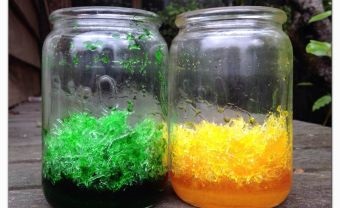Freezing salt water experiment
If you’re searching for freezing salt water experiment pictures information linked to the freezing salt water experiment keyword, you have visit the right blog. Our site always gives you hints for seeing the highest quality video and image content, please kindly hunt and locate more informative video content and graphics that fit your interests.
Freezing Salt Water Experiment. The thermometer reads zero degrees. Place a few ice cubes into one glass of water. Put the containers in a freezer this will take at few hours to freeze best done overnight and keep frozen until ready to perform experiment take the ice out of the containers and set them next to each other. To 10 0 c and observe the temperature as the water freezes.
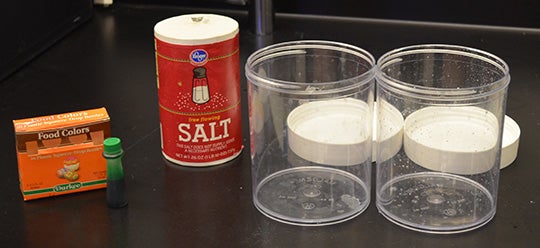 Fresh And Salt Water Experiment Ask A Biologist From askabiologist.asu.edu
Fresh And Salt Water Experiment Ask A Biologist From askabiologist.asu.edu
Amount of time it takes for the water to freeze constant variables. Adding green food coloring into the ice fresh water. Let s do a couple easy experiments to test for ourselves if salt really does affect the freezing point of water. In the university college london chemist andrea celler conducts an experiment to explain to us why salt water behaves vary differently than fresh water. In your salt water container dissolve 1 5 teaspoons of salt for every cup of water so if you have two cups use 3 teaspoons. Place both cups in the freezer for 3 or 4 hours.
To 10 0 c and observe the temperature as the water freezes.
Placing ice in fresh water. Add a few drops of food coloring into the ice water. Adding salt to water reduces its freezing point making it possible to lower the temperature of water below its normal freezing point without turning it to i. Click the add 50 g button to add 50 grams of salt to the water. Adding salt to tap water dependent variable. The experiment is ideal for demonstrating how salt depresses the freezing point of water.
 Source: m.youtube.com
Source: m.youtube.com
Be sure to mark which cup contains salt. Click the add 50 g button to add 50 grams of salt to the water. Lower the room temp. Amount of time it takes for the water to freeze constant variables. Add a few drops of food coloring into the ice water.
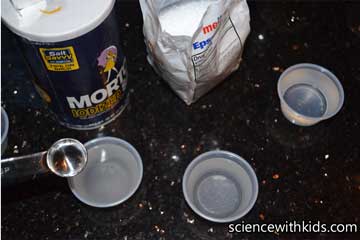 Source: sciencewithkids.com
Source: sciencewithkids.com
Place both cups in the freezer for 3 or 4 hours. Let s do a couple easy experiments to test for ourselves if salt really does affect the freezing point of water. Lower the room temp. Place both cups in the freezer for 3 or 4 hours. Adding green food coloring into the ice fresh water.
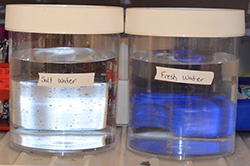 Source: askabiologist.asu.edu
Source: askabiologist.asu.edu
Add a few drops of food coloring into the ice water. Add a few drops of food coloring into the ice water. Amount of time it takes for the water to freeze constant variables. It is also a good introduction to the theories of latent heat. Take 2 plastic cups and fill them full with water.
 Source: easy-science-fair-projects.net
Source: easy-science-fair-projects.net
Let s do a couple easy experiments to test for ourselves if salt really does affect the freezing point of water. Be sure to mark which cup contains salt. Take 2 plastic cups and fill them full with water. What is the freezing point of this. Put the containers in a freezer this will take at few hours to freeze best done overnight and keep frozen until ready to perform experiment take the ice out of the containers and set them next to each other.
 Source: kids.wng.org
Source: kids.wng.org
Amount of time it takes for the water to freeze constant variables. Put the containers in a freezer this will take at few hours to freeze best done overnight and keep frozen until ready to perform experiment take the ice out of the containers and set them next to each other. Materials for salt and fresh water experiment method. Adding green food coloring into the ice fresh water. Add a few drops of food coloring into the ice water.
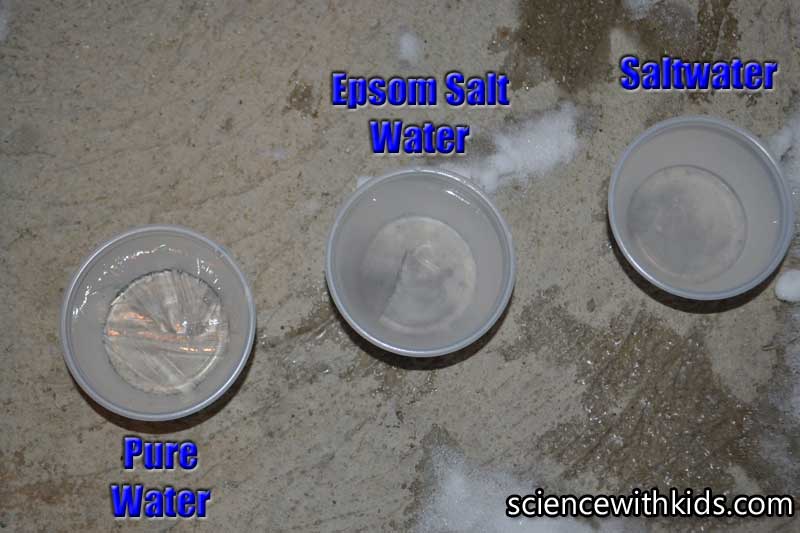 Source: sciencewithkids.com
Source: sciencewithkids.com
The thermometer reads zero degrees. One cup contains pure water whilst the other contains salt water. What is the freezing point of this. Put the containers in a freezer this will take at few hours to freeze best done overnight and keep frozen until ready to perform experiment take the ice out of the containers and set them next to each other. This exclusion of salt water from the process of freezing owing to the difference in crystalline structure of salt and ice is referred to as brine rejection process.
 Source: neighborhoodnature.wordpress.com
Source: neighborhoodnature.wordpress.com
Place a few ice cubes into one glass of water. In your salt water container dissolve 1 5 teaspoons of salt for every cup of water so if you have two cups use 3 teaspoons. It is also a good introduction to the theories of latent heat. Adding salt to tap water dependent variable. Lower the room temp.
 Source: commons.wikimedia.org
Source: commons.wikimedia.org
Lower the room temp. Add 2 tablespoons of salt to one of the cups and stir. To 10 0 c and observe the temperature as the water freezes. Take 2 plastic cups and fill them full with water. This experiment looks at the temperature of two cups of water as they are frozen.
Source: alcademics.com
Put the containers in a freezer this will take at few hours to freeze best done overnight and keep frozen until ready to perform experiment take the ice out of the containers and set them next to each other. Be sure to mark which cup contains salt. Adding salt to water reduces its freezing point making it possible to lower the temperature of water below its normal freezing point without turning it to i. Add 2 tablespoons of salt to one of the cups and stir. This experiment looks at the temperature of two cups of water as they are frozen.
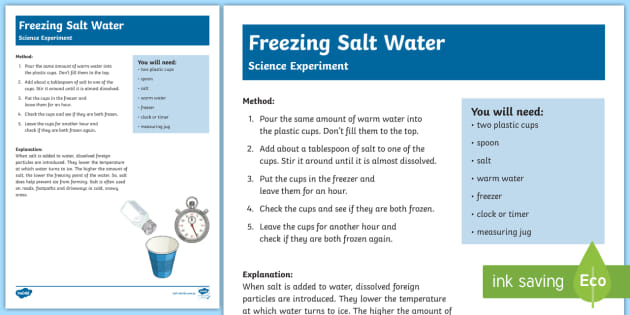 Source: twinkl.co.uk
Source: twinkl.co.uk
In your salt water container dissolve 1 5 teaspoons of salt for every cup of water so if you have two cups use 3 teaspoons. The thermometer reads zero degrees. Take 2 plastic cups and fill them full with water. The experiment is ideal for demonstrating how salt depresses the freezing point of water. Materials for salt and fresh water experiment method.
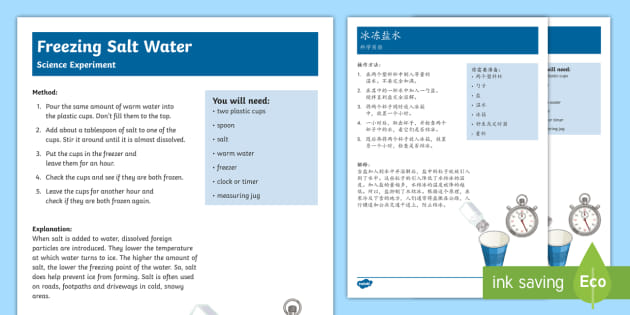 Source: twinkl.fr
Source: twinkl.fr
Click the add 50 g button to add 50 grams of salt to the water. Put the containers in a freezer this will take at few hours to freeze best done overnight and keep frozen until ready to perform experiment take the ice out of the containers and set them next to each other. Let s do a couple easy experiments to test for ourselves if salt really does affect the freezing point of water. Place a few ice cubes into one glass of water. Freezing of pure and salt water introduction.
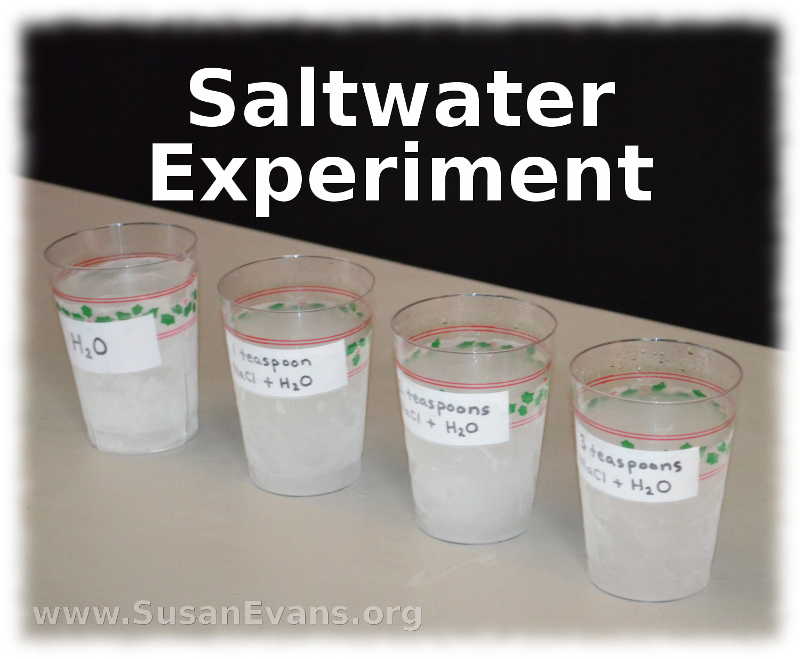 Source: blog.susanevans.org
Source: blog.susanevans.org
In order to understand the entire concept you can perform a small chemistry experiment on your own. In your salt water container dissolve 1 5 teaspoons of salt for every cup of water so if you have two cups use 3 teaspoons. Click the add 50 g button to add 50 grams of salt to the water. Adding salt to water reduces its freezing point making it possible to lower the temperature of water below its normal freezing point without turning it to i. The thermometer reads zero degrees.
 Source: pinterest.ca
Source: pinterest.ca
Add a few drops of food coloring into the ice water. This is both the freezing point of water and the melting point of ice. Freezing of pure and salt water introduction. In order to understand the entire concept you can perform a small chemistry experiment on your own. Click the add 50 g button to add 50 grams of salt to the water.
 Source: askabiologist.asu.edu
Source: askabiologist.asu.edu
Adding green food coloring into the ice fresh water. Adding salt to water reduces its freezing point making it possible to lower the temperature of water below its normal freezing point without turning it to i. Place both cups in the freezer for 3 or 4 hours. Add a few drops of food coloring into the ice water. Let s do a couple easy experiments to test for ourselves if salt really does affect the freezing point of water.
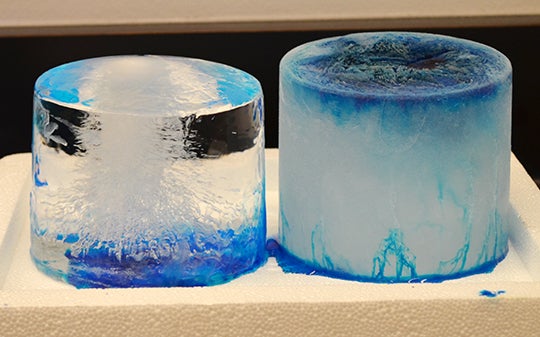 Source: askabiologist.asu.edu
Source: askabiologist.asu.edu
Place a few ice cubes into one glass of water. Freezing of pure and salt water introduction. Click the add 50 g button to add 50 grams of salt to the water. Adding salt to water reduces its freezing point making it possible to lower the temperature of water below its normal freezing point without turning it to i. Place both cups in the freezer for 3 or 4 hours.
If you find this site helpful, please support us by sharing this posts to your favorite social media accounts like Facebook, Instagram and so on or you can also bookmark this blog page with the title freezing salt water experiment by using Ctrl + D for devices a laptop with a Windows operating system or Command + D for laptops with an Apple operating system. If you use a smartphone, you can also use the drawer menu of the browser you are using. Whether it’s a Windows, Mac, iOS or Android operating system, you will still be able to bookmark this website.






